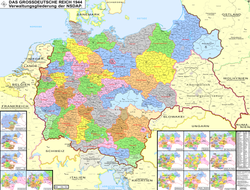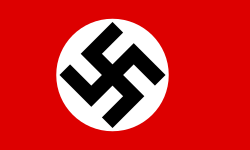| Reichsgau Tyrol-Vorarlberg | |||||||||||||
|---|---|---|---|---|---|---|---|---|---|---|---|---|---|
| Reichsgau of Nazi Germany | |||||||||||||
| 1938–1945 | |||||||||||||
 Map of Nazi Germany showing its administrative subdivisions ( Gaue and Reichsgaue ) | |||||||||||||
| Capital | Innsbruck | ||||||||||||
| Population | |||||||||||||
• 1939 | 330,892 | ||||||||||||
| Government | |||||||||||||
| Gauleiter | |||||||||||||
• 1938–1945 | Franz Hofer | ||||||||||||
| History | |||||||||||||
| 12 March 1938 | |||||||||||||
| 8 May 1945 | |||||||||||||
| |||||||||||||
| Today part of | Austria | ||||||||||||
The Reichsgau Tyrol-Vorarlberg (German: Reichsgau Tirol-Vorarlberg) was an administrative division of Nazi Germany consisting of Vorarlberg and North Tyrol (both in Austria). It existed from 1938 to 1945. It did not include East Tyrol (Lienz), which was instead part of Reichsgau Carinthia.
Contents
After the Italian Armistice with the Allies the Italian provinces of Belluno, South Tyrol and Trentino were placed under direct German control as the Operational Zone of the Alpine Foothills (Operationszone Alpenvorland, OZAV), which was de facto annexed and administered as part of Tyrol-Vorarlberg. [1]

